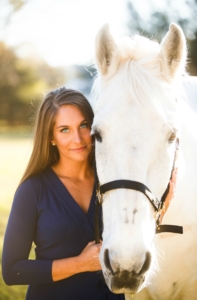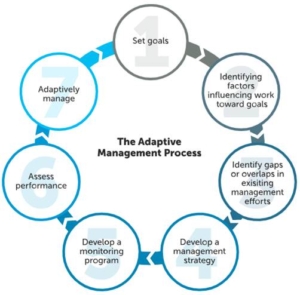
Emily Vazir (pictured here with Doc) is CRC’s Environmental Management Staffer working with the Chesapeake Bay Program’s Enhance Partnering, Leadership and Management Goal Implementation Team.
CRC’s Environmental Management Career Development Program works with the Chesapeake Bay Program partnership to offer three-year staff opportunities for science, management, and policy graduates as the partnership works to protect and restore the Chesapeake Bay. There are currently thirteen CRC Environmental Management Staffers supporting Chesapeake Bay Program initiatives for various lengths of time as each position follows its own timeline. The blended rotation of Staffers through the program affords new Staffers the opportunity to learn from the experiences of senior Staffers as they begin to navigate their way through the complexities of Chesapeake Bay restoration. We had the opportunity to sit down with Emily Vazir, one of our senior Staffers who supports the Bay Program’s Enhance Partnering, Leadership, and Management Goal Implementation Team, and take a look back at her time and experiences in the program.
CRC: Welcome, Emily! It is hard to believe we are already nearing the end of your tenure in the program. As you reflect on the almost three years you have spent with us at the Chesapeake Bay Program, do you feel like you have grown professionally?
Emily: I feel like I have grown in a couple of big ways during my time in the program. First, working in a partnership with as many players as are involved with the Chesapeake Bay Program, I feel like I had almost endless opportunity to further develop skills in network-building, collaboration, and public speaking. I was lucky to be part of a team where participation was highly encouraged, and that allowed me to become comfortable voicing ideas and opinions in a professional setting where participants come from all sectors, levels of management, etc. Second, this program has truly allowed me to apply the knowledge and skills I gained in school, while simultaneously teaching me about real-world applications and constraints of using science-based research in natural resource management and policy settings.
CRC: You support the work of the Enhance Partnering, Leadership, and Management Goal Implementation Team (GIT) which works to improve leadership and management of the Bay Program and help its partners build capacity to be environmental leaders within their own communities. You began your time in this position right as the GIT was designing the Strategic Review System (SRS) which is the process used to guide the partnership through the adaptive management cycle. What was it like to be a part of that development work and to then experience the program completing its first pass through the cycle?

The adaptive management cycle implemented by the Chesapeake Bay Program partnership.
Emily: It’s definitely been a journey from then to now. Drafting the initial SRS schedule was actually one of the first things I did when I started in this position, and to see how it’s developed and changed since is honestly a little mind boggling. The analogy has been made that, in the beginning, we were “laying down the tracks with the train coming right behind us,” and that sometimes felt true. I, and the whole SRS team, have put more blood, sweat, and tears into this system than you can imagine. Seeing the SRS through its first complete cycle and seeing the results of countless hours of collecting feedback and mapping out process improvements play out into a tangible, definable progress has been one of the highlights of my time in the program. Honestly, I think I’ll probably keep up with new developments even after my time in this position ends!
CRC: Your future professional goals are focused on fisheries and marine ecology and during your tenure you helped develop one of the indicators that will be used by the Bay Program’s Sustainable Fisheries Goal Implementation. Can you tell us about that work and how you found the process of reaching out to people outside of your immediate Goal Team to see how you could contribute to their work?
Emily: You know, I’ve always felt very fortunate in that my Goal Team is positioned in a way and tasked with efforts that often present a unique opportunity to interact with other Goal Teams and Workgroups. My background is in fisheries management and I knew that I wanted to continue adding to that experience during my time with the program, even if it wasn’t directly tied to my main responsibilities. I reached out to the Coordinator of the Sustainable Fisheries Goal Team and had an informal meeting where we talked about my professional development goals, research interests, and skills, and particularly if there were any complementary gaps in the work of that Goal Team that aligned well with the time and resources I had to offer.
We ended up identifying the Forage Fish outcome as one where “the stars aligned,” if you will. I worked with one of the NOAA analysts, and together she and I were able to develop a framework to base the indicator on and were also able to begin the process of using statistical analysis to bring a replicable quantitative aspect to the indicator. There still remains work to be done, and it is my hope that this indicator will become one that fishery managers use as they continue to find new and improved ways to monitor commercially managed species.
All of that said, there is really no limit on who a staffer can reach out to if they want to explore opportunities outside of their own Goal Team. In my experience, the people I reached out to were excited about the potential of bringing someone new into an area of work where they are passionate about making progress but may not have the necessary resources to dedicate to that specific issue. So I would encourage any new staffer to not be shy!

As part of the career development program, Emily participated in the University of Miami’s Shark Research and Conservation Program in July 2017.
CRC: As part of the professional development opportunities supported by the program, you recently attended the Association for the Sciences of Limnology and Oceanography’s (ASLO) 2019 meeting Puerto Rico. What was the most valuable part of that experience for you?
Emily: I would say the most valuable part of attending the ASLO conference was getting to see just how much effort there is going on worldwide to better understand and preserve global aquatic ecosystems. You really have no idea just how many organizations and institutions there are out there dedicated to this kind of work until you see it all gathered in one place like that. Another thing I found valuable was, by attending so many varying sessions throughout the conference, it brought new ideas and considerations to my own research interests. I’m hoping to be able to use these ideas going forward to pursue research, academic, and other goals.
CRC: As your time with us comes to a close, what advice would you give to a new Staffer entering the program?
Emily: Push yourself outside of your comfort zone. You may have a good idea about what your interests are, and what you see as your long-term career, academic, or other goals, but the opportunities to develop new skills and expertise are endless. Attend meetings of other Goal Teams and Workgroups if they are focused on topics of interest to you. Talk to the Goal Team Coordinators and Staffers, who are intimately familiar with the ins and outs of the program as it relates to their subject matter. People in this program, both inside and outside of the physical office, are willing and able to help you further your goals – so don’t be afraid to approach them, speak up in meetings of your peers, and throw ideas out for consideration (even if you think it sounds crazy)!
And professional development – I can’t stress that enough. Whatever your long-term goals are, be thoughtful about the professional development you undertake to get you there. The Staffers are an excellent resource for professional development ideas. If you decide to take on an independent research project as part of your professional development (or even if you don’t but have subject-matter expertise), try and present at as many conferences as you can. Whether it’s a poster session, an oral presentation, or something else, it presents an excellent opportunity to enhance public speaking skills, and at the same time is great way to expand your network for life after the program!
CRC: Thank you, Emily, for sharing your time and thoughts with us!
For additional information regarding CRC’s Environmental Management Career Development Program, please contact Melissa Fagan, Environmental Management Career Development Program Coordinator. Funding for CRC’s Environmental Management Career Development Program is provided through a cooperative agreement with the US EPA.
